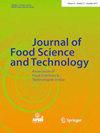NUTRITIONAL VALUE OF MASO31 RECIPE AND COMPLEMENTARY FEEDING ACCORDING TO THE WHO RECOMMENDATIONS IN KATANGA, DEMOCRATIC REPUBLIC OF THE CONGO
IF 3.3
3区 农林科学
Q2 FOOD SCIENCE & TECHNOLOGY
引用次数: 0
Abstract
Inappropriate complementary feeding is among the main causes of malnutrition worldwide. However, optimal complementary feeding is an effective child survival strategy ranked among the top life-saving interventions for children under 5 years. WHO and UNICEF underline the use of available food locally produced for children less than 2 years as a significant strategy to ensure the optimal complementary feeding. Maize-Soy blend in 3/1 proportion (MASO31) is consumed as complementary food in Katanga. Nevertheless, its nutritional value isn’t known nor its adequacy as additional food. This study aimed to evaluate the nutritional value of MASO31 content according to the WHO recommendations on complementary feeding. Two samples of MASO31 formulas were taken of two different preparations, for biochemical analysis nutrients data (energy, protein, Fe, Ca, P, Zn) in the Research and Agro Alimentary Analysis Center (CRAA) of Lubumbashi. The biochemical methods used were specific to analyze each nutrient data in MASO31 such as conversion factors and KJELDHAL. Comparative analysis of «MASO31» content was done using the WHO Complementary Feeding Recommendations as gold standard. Energy and nutrients content of 100g of «MASO31» were higher than the WHO Recommendations for complementary feeding period in daily need. But, calcium and phosphorus content was lower than the recommendations and needed improvements. The number of times that was proposed by ACANUDE NGO for «MASO31» to be fed is similar to the WHO recommendations on meal frequency in complementary feeding. MASO31 may be recommended in complementary feeding in DRC but calcium and phosphorus content should be enriched. Key words: Adequate complementary food, Complementary feeding, Democratic Republic of the Congo, Local complementary food and Nutritional value.根据世卫组织在刚果民主共和国加丹加的建议,maso31配方和补充喂养的营养价值
不适当的补充喂养是全世界营养不良的主要原因之一。然而,最佳补充喂养是一项有效的儿童生存战略,是五岁以下儿童最重要的拯救生命干预措施之一。世卫组织和儿童基金会强调,为两岁以下儿童使用当地生产的现有食品是确保最佳补充喂养的一项重要战略。在加丹加,玉米和大豆按3/1的比例混合(MASO31)作为辅食食用。然而,人们并不知道它的营养价值,也不知道它作为额外食物是否足够。本研究旨在根据世界卫生组织关于辅食的建议评价MASO31含量的营养价值。选取两种不同制剂的MASO31配方样品,在卢本巴希市研究与农业营养分析中心(CRAA)进行营养成分(能量、蛋白质、铁、钙、磷、锌)的生化分析。采用特定的生化方法分析MASO31中各营养素数据,如转化因子和KJELDHAL。使用世卫组织补充喂养建议作为金标准对“MASO31”含量进行了比较分析。100克“MASO31”的能量和营养素含量高于世界卫生组织建议的每日补充喂养期需求。但是,钙和磷的含量低于建议,需要改进。ACANUDE非政府组织提出的“MASO31”的喂养次数与世卫组织关于补充喂养中膳食频率的建议相似。在刚果民主共和国,可以推荐MASO31作为补饲饲料,但应增加钙和磷的含量。关键词:充足的辅食,辅食喂养,刚果民主共和国,当地辅食,营养价值
本文章由计算机程序翻译,如有差异,请以英文原文为准。
求助全文
约1分钟内获得全文
求助全文
来源期刊
CiteScore
7.70
自引率
0.00%
发文量
274
审稿时长
11 months
期刊介绍:
The Journal of Food Science and Technology (JFST) is the official publication of the Association of Food Scientists and Technologists of India (AFSTI). This monthly publishes peer-reviewed research papers and reviews in all branches of science, technology, packaging and engineering of foods and food products. Special emphasis is given to fundamental and applied research findings that have potential for enhancing product quality, extend shelf life of fresh and processed food products and improve process efficiency. Critical reviews on new perspectives in food handling and processing, innovative and emerging technologies and trends and future research in food products and food industry byproducts are also welcome. The journal also publishes book reviews relevant to all aspects of food science, technology and engineering.

 求助内容:
求助内容: 应助结果提醒方式:
应助结果提醒方式:


